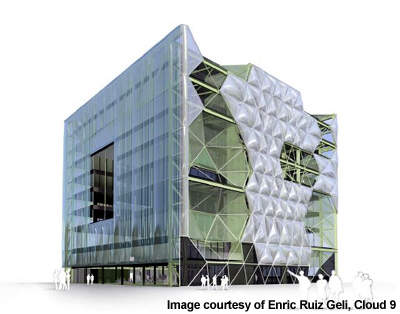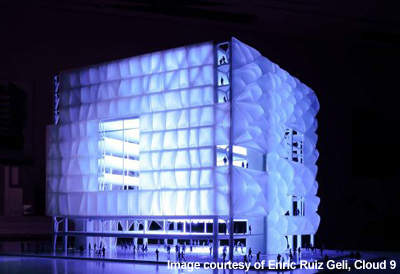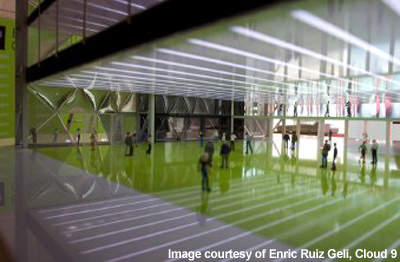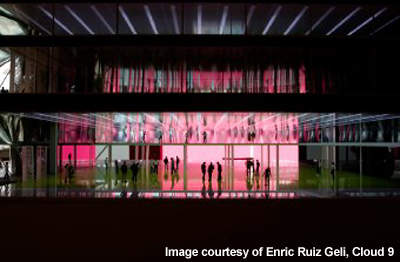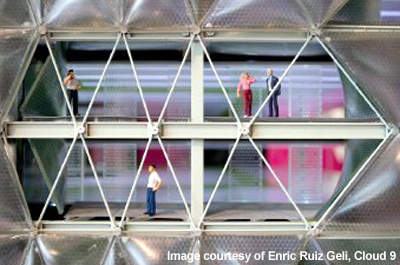The Media-TIC building in Barcelona is an information and communication technology hub designed to incubate, generate, exhibit and invite new ideas and developments in ICT.
The building was inaugurated in September 2010. Set in the new science and technology district of 22@Barcelona, which occupies 200ha in Barcelona’s industrial district of Poble Nou, the €20.8m building houses both office space for ICT businesses and exhibition space open to the general public. Together these elements create an environment of interaction between technology thinkers, inventors and users.
Catalonia developer El Consorci de la Zona Franca de Barcelona (CZFB) funded the project. The building was designed by Barcelona-based architects Cloud 9.
‘Performative’ architecture of Media-TIC building
In line with the pro-technology theme of the site, project architect and founder of Cloud 9 Enric Ruiz Geli made technology a central part of the building’s creation. The design team designed the building using CAD-CAM digital processes, and also incorporated advanced technologies into the actual architecture of the building to enhance energy efficiency.
Borrowing a term used by the former MoMA architecture and design curator Terry Riley, Ruiz describes the design as ‘performative architecture’: where the structure itself performs other functions.
“The theme of the Media-TIC building is how architecture creates a new balance with the digital use of energy,” says Ruiz Geli. “In the digital information era, architecture has to be a technological platform, in which connectivity, new materials and nanotechnology are important.”
The ‘performative’ elements in the Media-TIC building are found in two of the four façades, which are made of the eco-efficient material ethylene tetrafluoroethylene (ETFE) cladding.
The feature wall is the south-east façade facing Carrera de Sancho de Ávila, which will absorb six hours of sunlight a day. The ETFE cladding surface appears as a mosaic of concave and convex triangles,a design that is said to depict the merging of atoms or elements to make meaningful information, while also representing the process of digital construction.
Protection from the outside heat is achieved using what’s known as the ‘diaphragm’ configuration of ETFE cladding, whereby three layers of the plastic are fixed within the triangular frame and inflated like a pillow. The resulting bubble contains up to three air chambers that together create a shade-effect and provide thermal insulation for the building.
ETFE cladding was used for the south-west-facing façade, which is also exposed to six hours of sunlight daily. A different application of ETFE used is known as the ‘lenticular’ solution,where two layers of the plastic are inflated and filled with nitrogen. In this method, the air density of the particles creates a cloud-like solar filter.
In all, the project used 2,500m² of ETFE cladding, achieving energy savings of 20%.
The remaining façades receive only three hours of sunlight a day and use internal screen-type blinds for sun protection.
Media-TIC programme
The eight-level, 38m-high building is separated into three sections of varying density, offering a total floor space of 23,104m² and occupancy capacity for 2,418 people.
The ground floor, zero-density area provide 36m by 44m of open space and is home to the ICT Centre – a communications exhibition zone open to the public – the lobby, reception area, reception offices and a restaurant. Access to this level is via the two sun-facing façades.
An auditorium for 300 people is situated on the first floor. Offices occupy the low-density central levels (two to five), while the upper levels have high-density structural support for smaller spaces including more offices, bathrooms, roof terraces and courtyards.
Basement-level parking provides 201 car spaces, 26 motorbike spaces and four disabled parking spaces. The plot for the construction is 3,572m².
Materials used in Media-TIC building
Taking cues from the structural typology of industrial buildings in Poble Nou, Augusti Obiol from Spanish structural consultants, BOMA SL, used a metallic structure composed of four rigid, braced frames 14.25m apart.
The frames consist of metal fink truss-style beams made of seven and eight-section forged-metal girders. Each frame has a support beam that transfers its load to ‘galleries’, the rigid support centres.

